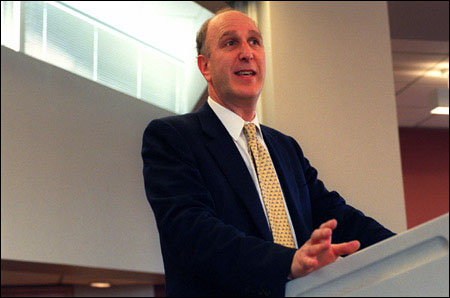Right of ’eminent domain’ challenged
Weighing the benefits of economic development

Susette Kelo is about to get her day in court.
This past September, the U.S. Supreme Court agreed to hear a case brought by Kelo and her fellow homeowners in the Fort Trumbull neighborhood of New London, Conn., challenging the right of municipal authorities to take their houses by eminent domain.
The case has attracted much attention because it is the first time such a case has come before the U.S. Supreme Court in 50 years and because it represents an opportunity to re-examine what some regard as a growing trend by state and municipal authorities to abuse the right of eminent domain.
Jerold Kayden, the Frank Backus Williams Professor of Urban Planning and Design at the Graduate School of Design, has been watching this case carefully for what it may presage about the future of property rights in the United States. On Nov. 16, he gave a talk on the subject sponsored by the Kennedy School of Government’s Taubman Center for State and Local Government.
“Can a single-family house and land be taken through eminent domain and turned over to a private developer to generate increased jobs and tax revenue? That is in essence the case that is now coming before the Supreme Court,” Kayden said.
Kayden explained that the right of eminent domain is sanctioned through implication by a phrase in the Fifth Amendment to the U.S. Constitution. The phrase rounds out a list of protections against unfair government interference, stating, “nor shall private property be taken for public use, without just compensation.” The nature of just compensation is always at issue in such cases, Kayden said, with property owners asking for more and government authorities offering less. What is more significant for Kelo v. New London, however, is the interpretation of the words, “public use.”
The issue first came before the Supreme Court in 1954 in the case Berman v. Parker when a department store owner in Washington, D.C., sued to prevent the government from demolishing his store to make way for an urban renewal project. Berman contended that it was unconstitutional to take his property under those circumstances, but the court ruled against him, saying that eminent domain was justified because the project was in the interest of the community.
That case set the stage for other cases in which governments took the property of private individuals not only for traditional public uses like highways, schools, or reservoirs, but also to replace “blighted” areas with new construction expected to create new jobs and bring in higher tax revenues.
For example, in the late 1970s, General Motors approached Coleman Young, then mayor of Detroit, with a request to build a Cadillac plant in a residential neighborhood known as Poletown. On the one hand, the plant would bring jobs and generate tax revenues, but, on the other, a settled neighborhood would be destroyed.
“It was a terrible choice. How do you even begin to decide a case like this? In the end, Young went along with General Motors, and the Michigan Supreme Court sided with the government.”
In deciding this case in 1981, the court ruled that the government’s decision to take the land was acceptable. But such cases are open to interpretation, a fact that was illustrated earlier this year when the Michigan Supreme Court reversed its 1981 decision by its ruling on a similar case, Wayne County v. Hathcock. The court ruled that the county could not use eminent domain to take the property of people living near an airport to clear the way for an economic development scheme known as the Pinnacle Project. The court ruled that the land could be taken if, for example, it could be shown to be blighted, but this was not the case.
Susette Kelo and the other residents of Fort Trumbull also firmly deny that their property is blighted, but what is at issue here is whether property can be taken simply because an alternative use of that property would produce greater economic benefits. In the Fort Trumbull example, the city of New London, Conn., wants to replace the residential area with offices and parking, among other things.
“It could be argued that a neighborhood of single-family houses is simply underperforming property,” Kayden said in answer to a question. “It doesn’t generate very much revenue compared with other uses. Consequently, one might label it as blight.”
Kayden would not predict how the U.S. Supreme Court would rule on this case, although he did speculate about the many different aspects of the case that the court might weigh in making its decision. The court might reconsider the purpose of the Constitution’s “just compensation” clause, perhaps taking into account the value of the individual’s identity and history or the “demoralization costs” incurred when people are forced to give up their homes to make way for a hotel or a block of high-priced condos. Or the court may shift the burden of decision back on the state courts.
“It’s a tricky issue,” Kayden said.




